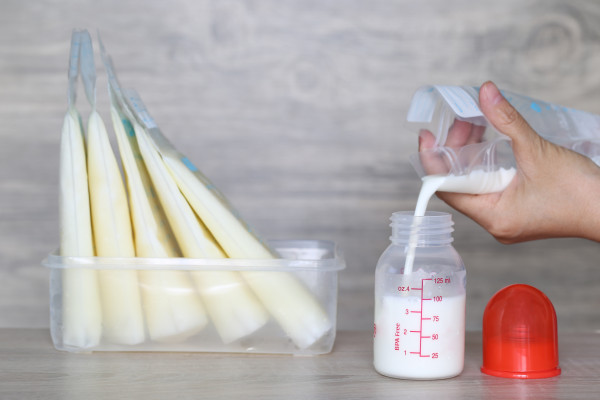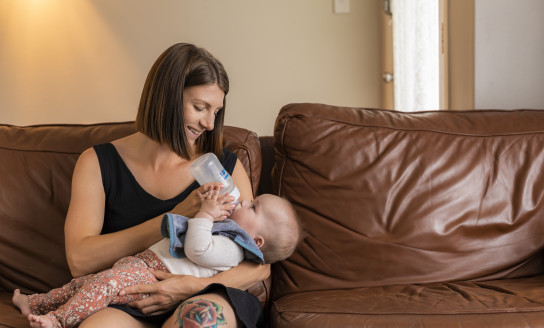What you’ll need to bottle-feed
To bottle-feed your baby expressed breastmilk or infant formula, you’ll need:
- four to eight bottles
- bottle rings and caps
- teats
- bottle brushes
- teat brushes
- steriliser (optional).
Teats are either made from silicone (clear) or latex (brown), and either is fine. You’ll notice they’re graded according to the size of the hole in the teat, or to the age of the baby. You may need to try different teats until you find one that you and your baby are happy with.
There are many different brands of bottles and teats on the market, and no particular brand is better than another. Just use the one that works best for you and your baby.
Cleaning and sterilising all bottle-feeding equipment is really important, because your baby’s immune system isn’t strong enough to fight off some infections. This is especially important in the first six months of infancy.
Please see Cleaning bottle-feeding equipment and Sterilising bottle-feeding equipment below for more information. Extra steps you can take when sterilising:
- Rinse the bottle three times after sterilisation with water that has been boiled and then cooled in a non-plastic container.
- Make the formula up in a non-plastic container, which is then cooled to a drinkable temperature and and poured into sterilised and rinsed bottles.
Warming expressed breastmilk

- The safest way to warm breastmilk is to stand the container in warm water. If you have fresh breastmilk, use that first. If you're using frozen breastmilk, you can thaw it by putting the container in either cool or warm water.
- After warming, gently swirl the bottle, and test the temperature to make sure it's lukewarm or around body temperature before you feed it to your baby.
Microwaves aren’t recommended for thawing or warming expressed breastmilk or formula. Microwaving destroys some of the components of breastmilk and can overheat or heat it unevenly, which may burn your baby’s mouth.
Warming infant formula
Many babies prefer their milk warmed to at least room temperature, but it’s fine to serve it cold if they prefer.
The safest way to warm formula is to stand the bottle in a bowl of warm water, or you can use a bottle warmer with a thermostat control if that better works for you. Just be careful not to leave the bottle in the warmer for more than 10 minutes. Harmful bacteria can grow in prepared formula.
After warming, gently swirl the bottle to mix the formula, and test the temperature by putting a few drops on your wrist. It should feel just warm.
If it’s too hot, cool it down by putting it in a bowl of cold water or by running it under the cold tap.
How to bottle-feed
- Test the flow of the formula or breastmilk by holding the bottle upside down when it’s filled with room-temperature or warmed milk. The liquid should drip steadily but not pour out. If you have to shake the bottle hard to see the drip, the flow’s too slow, and your baby might go to sleep before they drink what they need.
- Get comfortable, and cuddle your wee one close to you so they’re on an incline. This will help minimise wind.
- When you put the teat against baby’s lips they’ll open their mouth and start to suck. Keep the neck of the bottle at an angle so it’s filled with formula or milk.
- When your baby has drunk about half the formula or breastmilk, or when they stop sucking strongly, gently remove the bottle and try burping them. Once you’ve tried burping, offer the bottle again to see if they’re still hungry.
- While they’re feeding, there might be a bit of leakage at the corners of baby’s mouth. Don’t worry – this will stop as they get older.
If your baby’s normally breastfed, they might find it hard to pace themselves when bottle-feeding, and could end up drinking too much, too fast. If this is happening for your baby, try paced feeding, where you hold them upright to feed, and let them rest every few minutes.
Burping your baby
Responsive feeding
Responsive feeding is when the parent who is feeding the child, responds to the baby’s cues that they are full.
When you feed responsively, you can offer to feed your baby when they show signs they are hungry, and also when they seem distressed or lonely.
Responsive feeding is highly recommended as it helps you to not underfeed and overfeed your child.
If your little one is sucking their hand, wiggling, murmuring, crying, and/or is more alert and active – chances are they are trying to tell you that they are hungry.
Older tamariki might signal they are ready to eat by reaching for a spoon or dish, pointing to food, or simply by being excited when food is put in front of them.
Every child is different, but common signs of fullness are pushing food away, slower eating, or spitting out the nipple/bottle, or unlatching while breastfeeding.
Remember to follow your baby’s lead and never force a full feed – even if they haven’t eaten less than usual or not as much as you’d like them to. If you are concerned about your child’s eating habits, talk to your doctor, or call PlunketLine (0800 933 922).
When baby doesn’t finish the bottle
Babies know when they’ve had enough, so let them judge how much they need, and don’t worry if they don’t finish the bottle.
If your baby drifts off to sleep during a feed, try putting them over your shoulder, rubbing their back, or gently tickling their head, legs and tummy to wake them up. If that doesn’t work, a nappy change might. Wait till they’re fully awake before offering them the rest of the bottle.
Throw away any leftover formula or breastmilk after an hour. It’s risky to store half-empty bottles as they’re quickly contaminated after being sucked on, and after sitting at room temperature.
How much do bottle-feeding babies drink?
There’s no set number of feeds your baby should have in a day. All babies are different, and they each drink different amounts at each feed. Just feed them whenever they’re hungry and learn to recognise the cues your child gives you that they want to be fed. This is also known as 'responsive feeding'. It's also a good idea to use smaller bottles to prevent accidental overfeeding.
Babies fed with breastmilk
Babies fed with breastmilk need frequent feeding because the milk is easily digested – normally around six to eight times a day.
- Newborn babies sometimes feed up to 12 times a day.
- It varies a lot between babies, but between the ages of one to six months breastfed babies drink an average of 750-800 ml of breastmilk per day.
Babies fed with formula
For formula-fed babies, the number of feeds and the amount they drink at each feed varies too. Formula tins provide a guide on how much formula infants need for their age, but it's only a guide and might not suit your baby.
Some babies need more than the ‘required amount’ for their age and size, and others never drink that much. As long as your baby is active, has plenty of wet nappies, and is gaining weight over time, all is well.
Risks of bottle-feeding in baby's bed
Make sure you feed your baby before they go to sleep, rather than letting them fall asleep with a bottle in their mouth. That’s because of the risks of:
- choking: babies who fall asleep while bottle-feeding, or with the teat in their mouth, can draw liquid into their lungs, and inhale or choke on it
- tooth decay: if your baby falls asleep with a bottle, the milk could slowly drip into your baby’s mouth, soaking their teeth. Overnight, the bacteria can build up and do some real damage to those baby teeth and gums
- ear infections: if your baby drinks while lying flat, milk can drain into their ear cavity, which can cause ear infections.
If they need to sleep with something in their mouth, a pacifier/dummy is a better alternative. Be aware that if your baby gets used to falling asleep with something in their mouth, they might depend on it to get to sleep, and struggle to settle independently.
Using a feeding cup
When your baby’s around six months old, you can start using a feeding cup (or sipper cup) to teach your baby how to drink from a cup. You should continue to thoroughly wash the feeding cups containing infant formula or breastmilk until your baby is 12 months old.
Cleaning bottle-feeding equipment
It’s important to clean your bottles, teats, rings and caps after every feed, and it’s best to do it straight after a feed. You need to clean the equipment before you sterilise it.
Here’s how to clean bottle-feeding equipment:
- wash your hands with soap and water, and dry them with a paper towel or clean cloth
- fill the sink with hot, soapy water
- use the bottle brush to clean the bottles, inside and out
- squirt water through teats to clear the little hole
- use a teat brush to clean the teats inside and out, checking for any cracks in the teats as you go. Throw away any damaged teats, because bacteria can grow inside the cracks.
- clean the bottle rings and caps
- rinse everything well in hot water, and leave them to air dry.
Sterilising bottle-feeding equipment
After you’ve cleaned your bottle-feeding equipment, it’s important to sterilise it by boiling, steaming, or with chemicals.
Boiling
Boiling is the easiest and most reliable way to sterilise your bottle-feeding equipment.
- Fill a large pot with water.
- Put all the washed items in the water, making sure everything is covered and no air is trapped inside bottles, teats, rings or caps.
- Put the lid on the pot, bring the water to the boil and boil for five minutes.
- Leave everything to cool in the pot until you can take it out without scalding yourself. Make sure you use sterilised tongs or clean hands to take the items out of the pot.
- Store equipment you won’t use straight away in a clean, sealed container in the fridge.
- Use all equipment within 24 hours of boiling.
Steam sterilisers
You can buy electric (plug-in) or microwave steam sterilisers. These units 'cook' your equipment at a temperature high enough to kill bacteria.
- Put your clean bottle-feeding equipment into the unit.
- Add water according to the manufacturer’s instructions.
- If you’re using an electric unit, switch it on. The unit switches itself off when the job is done.
- If you’re using a microwave steam steriliser:
- check the manufacturer’s instructions before use, and follow those instructions carefully
- make sure you check the microwave power needed, because not all microwave ovens are the same
- never put any metal inside a microwave.
- Never put your bottle-feeding equipment straight in the microwave to sterilise it – not only will it not work, but you’ll also damage or melt your bottle-feeding equipment.
Chemical sterilisers
Follow the instructions on the box or packet.
